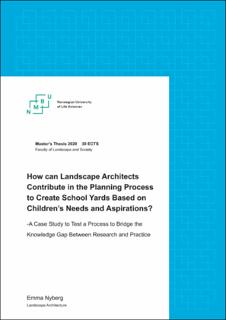| dc.contributor.advisor | Thorén, Anne-Karine Halvorsen | |
| dc.contributor.advisor | Evensen, Katinka Horgen | |
| dc.contributor.author | Nyberg, Emma Kristina | |
| dc.coverage.spatial | Norway, Oslo | en_US |
| dc.date.accessioned | 2021-01-27T10:39:48Z | |
| dc.date.available | 2021-01-27T10:39:48Z | |
| dc.date.issued | 2020 | |
| dc.identifier.uri | https://hdl.handle.net/11250/2724949 | |
| dc.description.abstract | Through research, we know that high quality outdoor environments have positive health effects in children. Research also show the importance of including children in planning the spaces they are to use. We have laws, regulations and guidelines that all intend to ensure good quality in children’s outdoor environments, as well as children’s right to be heard and respected. Yet, evaluations show that the knowledge we have is not applied in practice by policymakers, planners and designers. This can be described as a knowledge gap between research and practice in the field of children’s environments and may have several causes. One of them is that policymakers, planners and designers find it challenging to access the knowledge and also that the knowledge is not written in a way that can be translated into design in the landscape. This master thesis focuses on school yards and explores a process to utilize research-based knowledge on quality in school yards and translate it into design, by using a quality assessment tool, a user-group participation study as well as the knowledge of the landscape architect. The aim is to try to bridge the gap. The methods used are based on the concept of affordances, focusing on what the children can and want to do in their school yard. The process proved to be successful in the case tested in this assignment, and the conclusion from this project is that using the methods demonstrated in this master thesis can help guide the design and be a way for landscape architects to contribute in the planning process and so promoting better quality in school yards. For this to happen, landscape architects need to have a clear definition of their role in the planning process. | en_US |
| dc.language.iso | eng | en_US |
| dc.publisher | Norwegian University of Life Sciences, Ås | en_US |
| dc.rights | Attribution-NonCommercial-NoDerivatives 4.0 Internasjonal | * |
| dc.rights.uri | http://creativecommons.org/licenses/by-nc-nd/4.0/deed.no | * |
| dc.subject | school yards | en_US |
| dc.subject | children’s outdoor environments | en_US |
| dc.subject | Playgrounds | en_US |
| dc.subject | User-group participation | en_US |
| dc.subject | Children | en_US |
| dc.title | How can landscape architects contribute in the planning process to create school yards based on children’s needs and aspirations? : a case study to test a process to bridge the knowledge gap between research and practice | en_US |
| dc.type | Master thesis | en_US |
| dc.source.pagenumber | 120 | en_US |
| dc.description.localcode | M-LA | en_US |

